Characterizing Sparse Spectral Diversity Within a Homogenous Background: Hydrocarbon Production Infrastructure in Arctic Tundra near Prudhoe Bay, Alaska
Abstract
:1. Introduction
- To what extent can misfit (both aggregate and wavelength-explicit residuals) of a generalized linear spectral mixture model provide additional information about spectral diversity of the built environment in Arctic tundra?
- How do readily identifiable spectral endmembers in high misfit pixels compare to those identified from full images?
- How do the spectral endmember signatures identified using the spectral mixture residual compare to results using reflectance alone?
- 2.
- How does characterization vary with spectral resolution?
- What, if any, target signatures are identified from AVIRIS-3 which are not present in simulated Sentinel-2?
- 3.
- How (if at all) do the answers to Questions 1 and 2 above vary with simulated coarsening spatial resolution?
- What, if any, signals are identified at 4 m resolution are and are not retained at the 30 m resolution of a potential future spaceborne imaging spectroscopy mission?
2. Materials and Methods
2.1. Study Area
2.2. Methods
2.2.1. Data
2.2.2. Analysis
2.2.3. Workflow
- Evaluate spectroscopic diversity in reflectance data using PCA;
- Evaluate spectroscopic diversity in reflectance data using UMAP;
- Apply spectral mixture residual;
- Evaluate spectroscopic diversity in mixture residual data using PCA;
- Evaluate spectroscopic diversity in mixture residual data using UMAP;
- Map anthropogenic targets;
- Spatially blur to simulate point spread functions of coarser image data;
- Evaluate change in characterization and mapping to loss of spatial resolution;
- Spectrally convolve to mimic multispectral imaging sensors;
- Evaluate change in characterization and mapping to loss of spectral resolution.
3. Results
3.1. Research Question 1: Informing Spectral Characterization with Mixture Model Residual
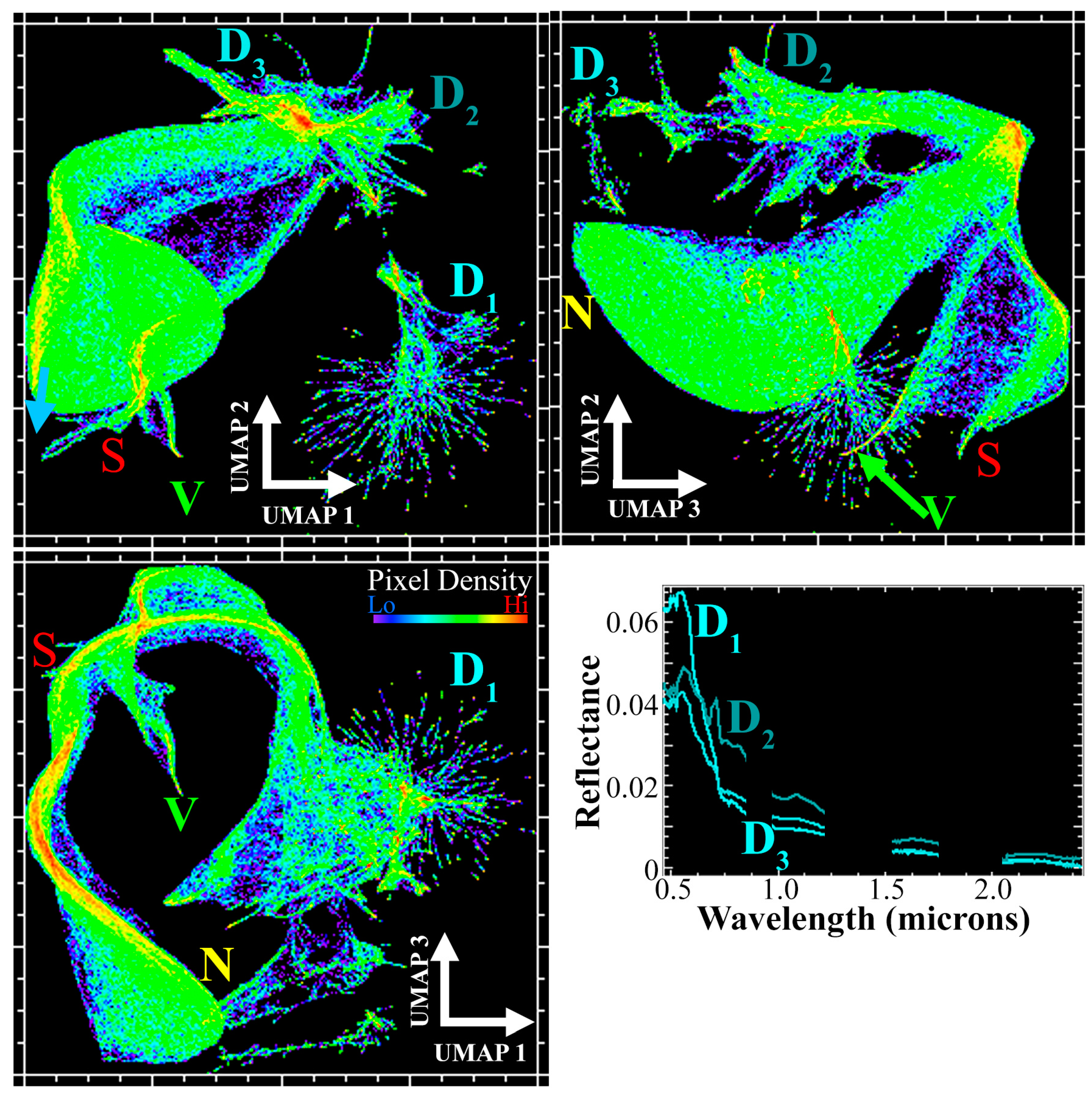
3.2. Research Question 2: Effect of Spatial Resolution
3.3. Research Question 3: Effect of Spectral Resolution
4. Discussion
4.1. Synthesis of Key Results
4.2. Implications for Other Arctic Studies
4.3. Limitations
4.4. Avenues for Future Work
5. Conclusions
Author Contributions
Funding
Data Availability Statement
Acknowledgments
Conflicts of Interest
Appendix A
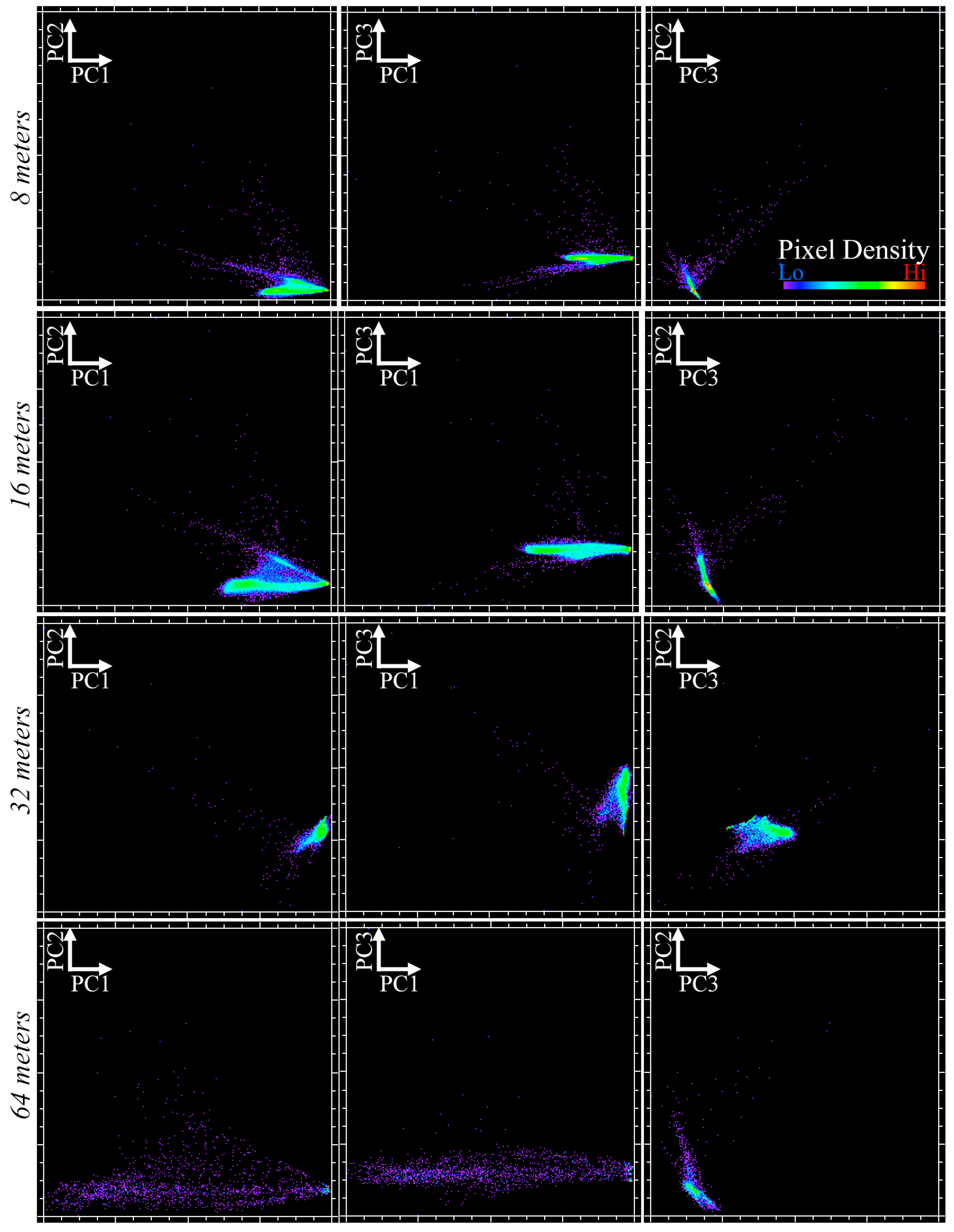
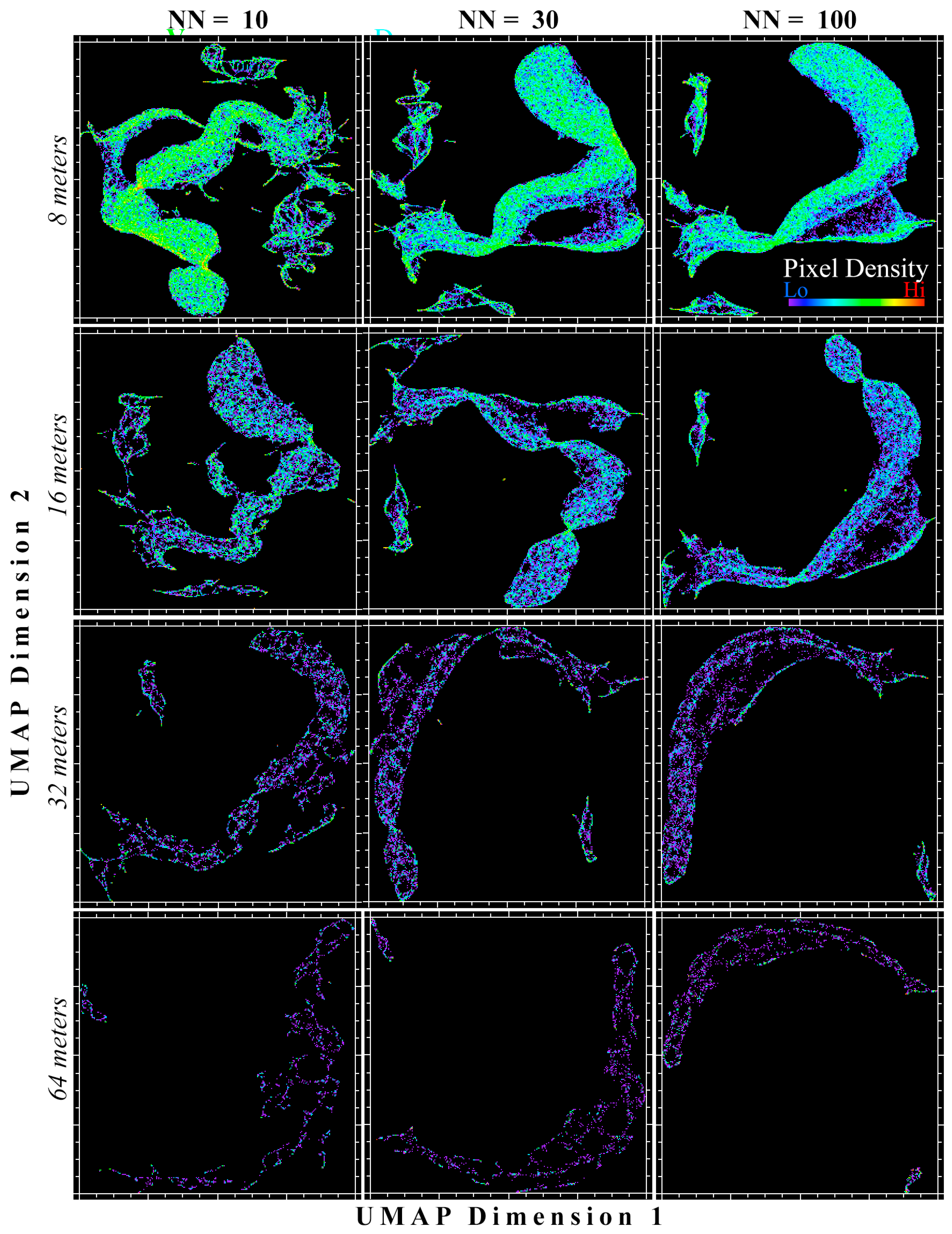
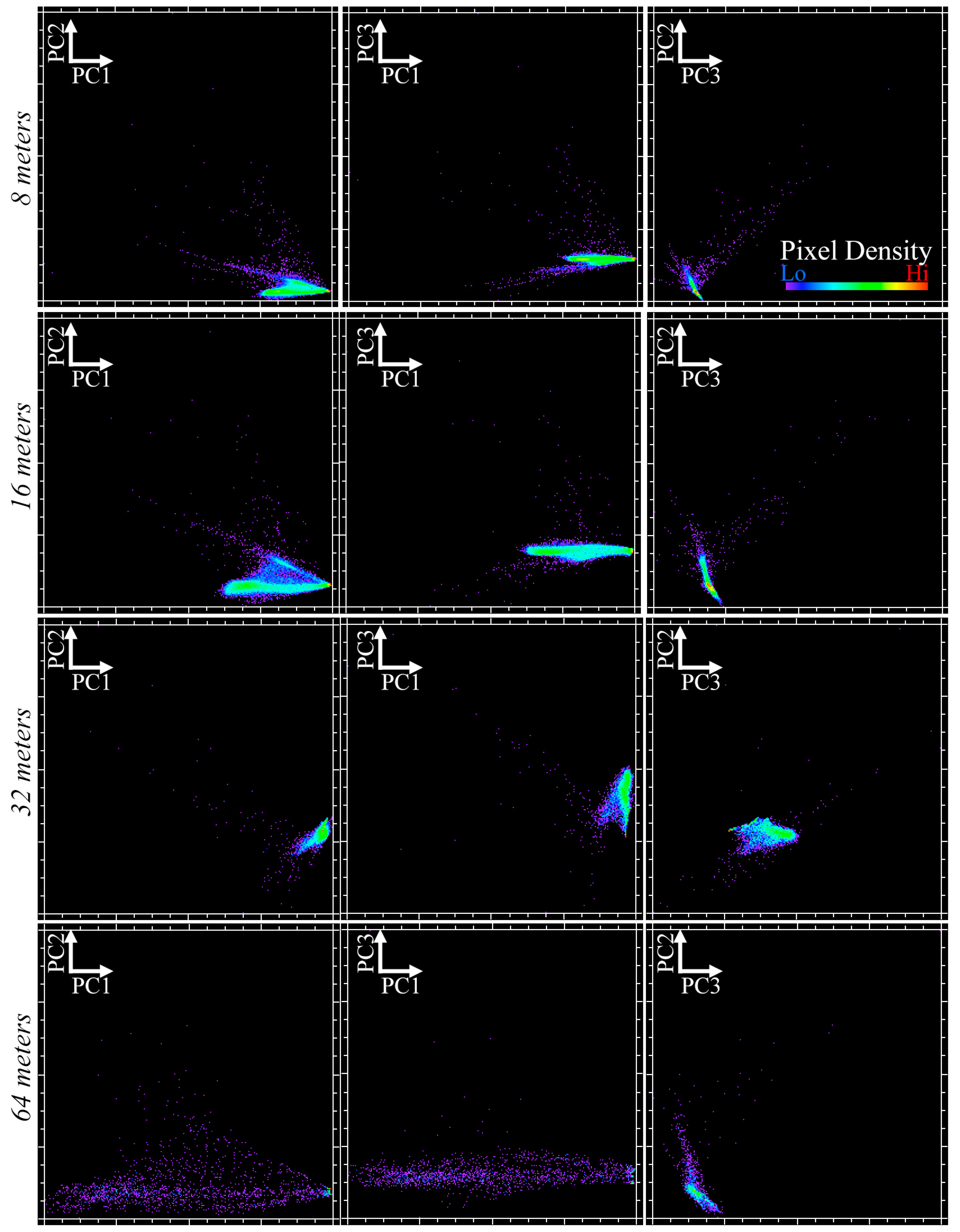
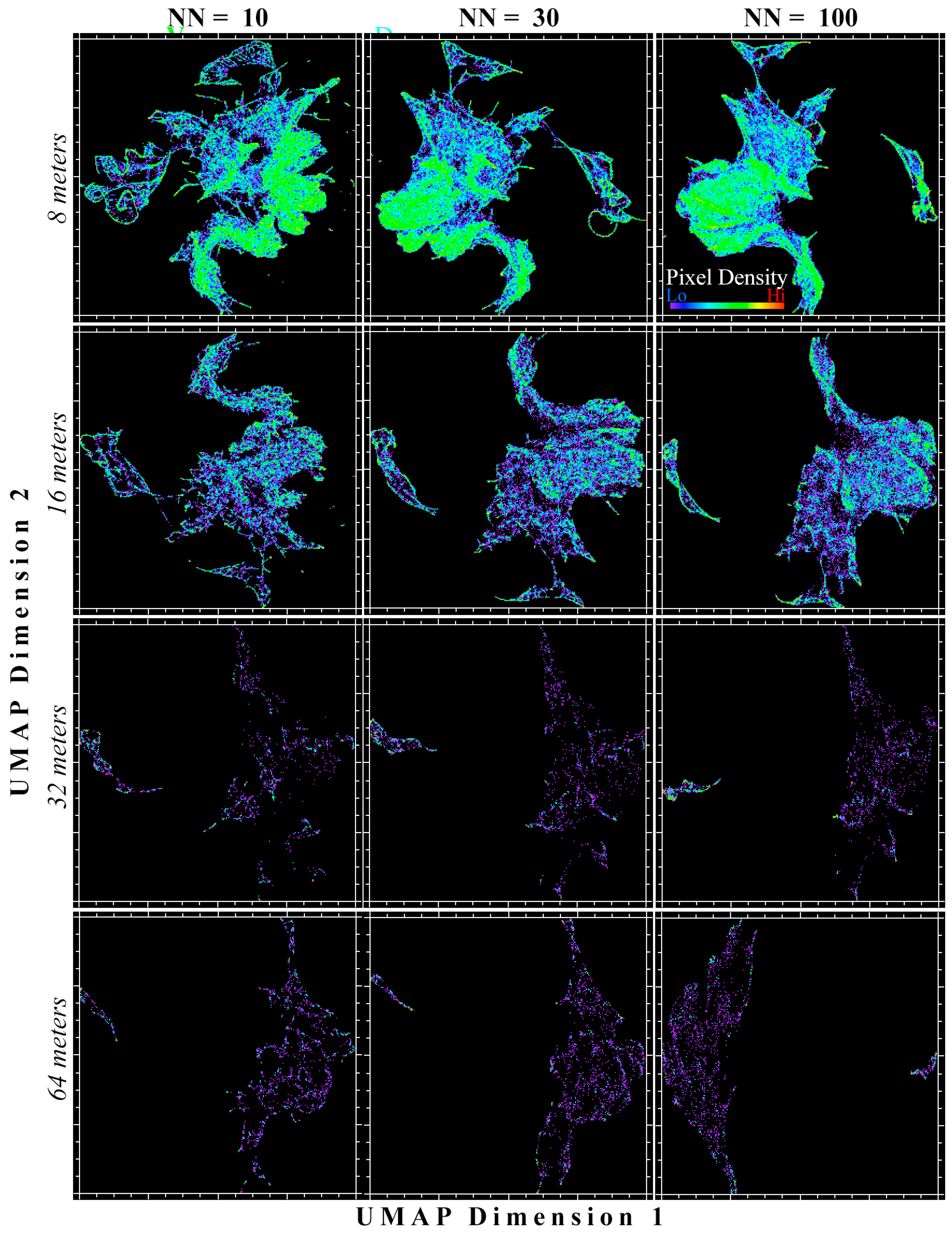
References
- Turin, G. An Introduction to Matched Filters. IRE Trans. Inf. Theory 1960, 6, 311–329. [Google Scholar] [CrossRef]
- Woodward, P.M. Information Theory and the Design of Radar Receivers. Proc. IRE 1951, 39, 1521–1524. [Google Scholar] [CrossRef]
- Boardman, J.W. Leveraging the High Dimensionality of AVIRIS Data for Improved Sub-Pixel Target Unmixing and Rejection of False Positives: Mixture Tuned Matched Filtering; NASA Jet Propulsion Laboratory: Pasadena, CA, USA, 1998; Volume 97, pp. 55–56.
- Harsanyi, J.C.; Chang, C.-I. Hyperspectral Image Classification and Dimensionality Reduction: An Orthogonal Subspace Projection Approach. IEEE Trans. Geosci. Remote Sens. 1994, 32, 779–785. [Google Scholar] [CrossRef]
- Reed, I.S.; Yu, X. Adaptive Multiple-Band CFAR Detection of an Optical Pattern with Unknown Spectral Distribution. IEEE Trans. Acoust. Speech Signal Process. 1990, 38, 1760–1770. [Google Scholar] [CrossRef]
- Thompson, D.; Leifer, I.; Bovensmann, H.; Eastwood, M.; Fladeland, M.; Frankenberg, C.; Gerilowski, K.; Green, R.; Kratwurst, S.; Krings, T. Real-Time Remote Detection and Measurement for Airborne Imaging Spectroscopy: A Case Study with Methane. Atmos. Meas. Tech. 2015, 8, 4383–4397. [Google Scholar] [CrossRef]
- Nasrabadi, N.M. Hyperspectral Target Detection: An Overview of Current and Future Challenges. IEEE Signal Process. Mag. 2013, 31, 34–44. [Google Scholar] [CrossRef]
- Pearson, K. LIII. On Lines and Planes of Closest Fit to Systems of Points in Space. Null 1901, 2, 559–572. [Google Scholar] [CrossRef]
- Ans, B.; Hérault, J.; Jutten, C. Architectures Neuromimétiques Adaptatives: Détection de Primitives. Proc. Cogn. 1985, 85, 593–597. [Google Scholar]
- Gordon, C. A Generalization of the Maximum Noise Fraction Transform. IEEE Trans. Geosci. Remote Sens. 2000, 38, 608–610. [Google Scholar] [CrossRef]
- Plaza, A.; Chang, C.-I. Fast Implementation of Pixel Purity Index Algorithm; SPIE: Bellingham, WA, USA, 2005; Volume 5806, pp. 307–317. [Google Scholar]
- Clark, R.N.; King, T.V. Automatic Continuum Analysis of Reflectance Spectra. In Proceedings of the 3rd Airborne Imaging Spectrometer Data Analysis Workshop; NASA NTRS N88-13770, Document ID 19880004388; Jet Propulsion Laboratory: Pasadena, CA, USA, 1987; pp. 138–142. [Google Scholar]
- Savitzky, A.; Golay, M.J. Smoothing and Differentiation of Data by Simplified Least Squares Procedures. Anal. Chem. 1964, 36, 1627–1639. [Google Scholar] [CrossRef]
- Crist, E.P.; Cicone, R.C. A Physically-Based Transformation of Thematic Mapper Data—The TM Tasseled Cap. IEEE Trans. Geosci. Remote Sens. 1984, GE-22, 256–263. [Google Scholar] [CrossRef]
- Kauth, R.J.; Thomas, G.S. The Tasselled Cap—A Graphic Description of the Spectral-Temporal Development of Agricultural Crops as Seen by LANDSAT. In Proceedings of the Symposium on Machine Processing of Remotely Sensed Data, West Lafayette, IN, USA, 29 July–1 August 1976; The Laboratory for Applications of Remote Sensing, Purdue University: West Lafayette, IN, USA, 1976; pp. 41–51. [Google Scholar]
- Sousa, D.; Brodrick, P.G.; Cawse-Nicholson, K.; Fisher, J.B.; Pavlick, R.; Small, C.; Thompson, D.R. The Spectral Mixture Residual: A Source of Low-Variance Information to Enhance the Explainability and Accuracy of Surface Biology and Geology Retrievals. J. Geophys. Res. Biogeosci. 2022, 127, e2021JG006672. [Google Scholar] [CrossRef]
- Sousa, D.; Small, C. Topological Generality and Spectral Dimensionality in the Earth Mineral Dust Source Investigation (EMIT) Using Joint Characterization and the Spectral Mixture Residual. Remote Sens. 2023, 15, 2295. [Google Scholar] [CrossRef]
- Sousa, D.; Small, C. Multisensor Analysis of Spectral Dimensionality and Soil Diversity in the Great Central Valley of California. Sensors 2018, 18, 583. [Google Scholar] [CrossRef]
- Small, C. The Landsat ETM+ Spectral Mixing Space. Remote Sens. Environ. 2004, 93, 1–17. [Google Scholar] [CrossRef]
- Small, C.; Milesi, C. Multi-Scale Standardized Spectral Mixture Models. Remote Sens. Environ. 2013, 136, 442–454. [Google Scholar] [CrossRef]
- Sousa, D.; Small, C. Globally Standardized MODIS Spectral Mixture Models. Remote Sens. Lett. 2019, 10, 1018–1027. [Google Scholar] [CrossRef]
- Sousa, D.; Small, C. Global Cross-Calibration of Landsat Spectral Mixture Models. Remote Sens. Environ. 2017, 192, 139–149. [Google Scholar] [CrossRef]
- Green, R.O.; Schaepman, M.E.; Mouroulis, P.; Geier, S.; Shaw, L.; Hueini, A.; Bernas, M.; McKinley, I.; Smith, C.; Wehbe, R. Airborne Visible/Infrared Imaging Spectrometer 3 (AVIRIS-3); IEEE: Big Sky, MT, USA, 2022; pp. 1–10. [Google Scholar]
- Bradley, C.L.; Thingvold, E.; Moore, L.B.; Haag, J.M.; Raouf, N.A.; Mouroulis, P.; Green, R.O. Optical Design of the Earth Surface Mineral Dust Source Investigation (EMIT) Imaging Spectrometer; Jet Propulsion Laboratory, National Aeronautics and Space Administration: Pasadena, CA, USA, 2020; Volume 11504, p. 1150402.
- Thompson, D.R.; Natraj, V.; Green, R.O.; Helmlinger, M.C.; Gao, B.-C.; Eastwood, M.L. Optimal Estimation for Imaging Spectrometer Atmospheric Correction. Remote Sens. Environ. 2018, 216, 355–373. [Google Scholar] [CrossRef]
- Thompson, D.R.; Brodrick, P.G.; Green, R.O.; Kalashnikova, O.; Lundeen, S.; Okin, G.; Olson-Duvall, W.; Painter, T. EMIT L2A Algorithm: Surface Reflectance and Scene Content Masks—Theoretical Basis; Earth Mineral Dust Source InvesTigation (EMIT); Jet Propulsion Laboratory, California Institute of Technology: Pasadena, CA, USA, 2020; p. 23.
- Sousa, D.; Small, C. Joint Characterization of Multiscale Information in High Dimensional Data. Adv. Artif. Intell. Mach. Learn. 2021, 1, 196–212. [Google Scholar] [CrossRef]
- McInnes, L. UMAP: Uniform Manifold Approximation and Projection for Dimension Reduction—Umap 0.5 Documentation. Available online: https://umap-learn.readthedocs.io/en/latest/ (accessed on 13 October 2022).
- Meilă, M.; Zhang, H. Manifold Learning: What, How, and Why. Annu. Rev. Stat. Appl. 2024, 11, 393–417. [Google Scholar] [CrossRef]
- van der Maaten, L.; Hinton, G. Visualizing Data Using T-SNE. J. Mach. Learn. Res. 2008, 9, 2579–2605. [Google Scholar]
- Donoho, D.L.; Grimes, C. Hessian Eigenmaps: Locally Linear Embedding Techniques for High-Dimensional Data. Proc. Natl. Acad. Sci. USA 2003, 100, 5591–5596. [Google Scholar] [CrossRef] [PubMed]
- Kim, D.H.; Finkel, L.H. Hyperspectral Image Processing Using Locally Linear Embedding; IEEE: Capri, Italy, 2003; pp. 316–319. [Google Scholar]
- Roweis, S.T.; Saul, L.K. Nonlinear Dimensionality Reduction by Locally Linear Embedding. Science 2000, 290, 2323–2326. [Google Scholar] [CrossRef] [PubMed]
- Jiale, Y.; Ying, Z. Visualization Method of Sound Effect Retrieval Based on UMAP. In Proceedings of the 2020 IEEE 4th Information Technology, Networking, Electronic and Automation Control Conference (ITNEC), Chongqing, China, 12–14 June 2020; Volume 1, pp. 2216–2220. [Google Scholar]
- Zhang, Q.; Liu, Y.; Fang, H. Manifold Learning-Based UMAP Method for Geochemical Anomaly Identification. Geochemistry 2024, 84, 126157. [Google Scholar] [CrossRef]
- Casanova, R.; Lyday, R.G.; Bahrami, M.; Burdette, J.H.; Simpson, S.L.; Laurienti, P.J. Embedding Functional Brain Networks in Low Dimensional Spaces Using Manifold Learning Techniques. Front. Neuroinform. 2021, 15, 740143. [Google Scholar] [CrossRef] [PubMed]
- Sousa, D.; Mayes, M.; Davis, F.; Fisher, J.B. Characterization of California Plant Communities with the Mixture Residual. In Proceedings of the Hyperspectral Imaging and Sounding of the Environment (HISE), Vancouver, BC, Canada, 19–23 July 2021; Optical Society of America: Vancouver, CA, USA, 2021; p. 2. [Google Scholar]
- Sousa, F.J.; Sousa, D.J. Hyperspectral Reconnaissance: Joint Characterization of the Spectral Mixture Residual Delineates Geologic Unit Boundaries in the White Mountains, CA. Remote Sens. 2022, 14, 4914. [Google Scholar] [CrossRef]
- Drusch, M.; Del Bello, U.; Carlier, S.; Colin, O.; Fernandez, V.; Gascon, F.; Hoersch, B.; Isola, C.; Laberinti, P.; Martimort, P. Sentinel-2: ESA’s Optical High-Resolution Mission for GMES Operational Services. Remote Sens. Environ. 2012, 120, 25–36. [Google Scholar] [CrossRef]
- Nelson, P.R.; Maguire, A.J.; Pierrat, Z.; Orcutt, E.L.; Yang, D.; Serbin, S.; Frost, G.V.; Macander, M.J.; Magney, T.S.; Thompson, D.R. Remote Sensing of Tundra Ecosystems Using High Spectral Resolution Reflectance: Opportunities and Challenges. J. Geophys. Res. Biogeosci. 2022, 127, e2021JG006697. [Google Scholar] [CrossRef]
- Miner, K.R.; Turetsky, M.R.; Malina, E.; Bartsch, A.; Tamminen, J.; McGuire, A.D.; Fix, A.; Sweeney, C.; Elder, C.D.; Miller, C.E. Permafrost Carbon Emissions in a Changing Arctic. Nat. Rev. Earth Environ. 2022, 3, 55–67. [Google Scholar] [CrossRef]
- Rantanen, M.; Karpechko, A.Y.; Lipponen, A.; Nordling, K.; Hyvärinen, O.; Ruosteenoja, K.; Vihma, T.; Laaksonen, A. The Arctic Has Warmed Nearly Four Times Faster than the Globe since 1979. Commun. Earth Environ. 2022, 3, 168. [Google Scholar] [CrossRef]
- Hayward, J.; Johnston, L.; Jackson, A.; Jamieson, R. Hydrological Analysis of Municipal Source Water Availability in the Canadian Arctic Territory of Nunavut. Arctic 2021, 74, 30–41. [Google Scholar] [CrossRef]
- Ayeb-Karlsson, S.; Hoad, A.; Trueba, M.L. ‘My Appetite and Mind Would Go’: Inuit Perceptions of (Im)Mobility and Wellbeing Loss under Climate Change across Inuit Nunangat in the Canadian Arctic. Humanit. Soc. Sci. Commun. 2024, 11, 277. [Google Scholar] [CrossRef]
- Debortoli, N.S.; Clark, D.G.; Ford, J.D.; Sayles, J.S.; Diaconescu, E.P. An Integrative Climate Change Vulnerability Index for Arctic Aviation and Marine Transportation. Nat. Commun. 2019, 10, 2596. [Google Scholar] [CrossRef] [PubMed]
- Abakumov, E.; Petrov, A.; Polyakov, V.; Nizamutdinov, T. Soil Organic Matter in Urban Areas of the Russian Arctic: A Review. Atmosphere 2023, 14, 997. [Google Scholar] [CrossRef]
- Scheer, J.; Tomaškovičová, S.; Ingeman-Nielsen, T. Thaw Settlement Susceptibility Mapping for Roads on Permafrost-Towards Climate-Resilient and Cost-Efficient Infrastructure in the Arctic. Cold Reg. Sci. Technol. 2024, 220, 104136. [Google Scholar] [CrossRef]
- Bushnell, E.; Miner, K.; Sousa, D.; Baskaran, L. A Review of Emergent Vulnerabilities Indices in the Alaskan Arctic. ESS Open Arch. 2024. [Google Scholar] [CrossRef]
- Wang, J.; Zhang, F.; Yang, Z.J.; Yang, P. Experimental Investigation on the Mechanical Properties of Thawed Deep Permafrost from the Kuparuk River Delta of the North Slope of Alaska. Cold Reg. Sci. Technol. 2022, 195, 103482. [Google Scholar] [CrossRef]
- Cao, Y.; Ma, W.; Li, G.; Gao, K.; Li, C.; Chen, D.; Shang, Y.; Wei, X.; Chen, Z.; Wu, G. Rapid Permafrost Thaw under Buried Oil Pipeline and Effective Solution Using a Novel Mitigative Technique Based on Field and Laboratory Results. Cold Reg. Sci. Technol. 2024, 219, 104119. [Google Scholar] [CrossRef]
- Nevalainen, M.; Vanhatalo, J.; Helle, I. Index-based Approach for Estimating Vulnerability of Arctic Biota to Oil Spills. Ecosphere 2019, 10, e02766. [Google Scholar] [CrossRef]
- Fisher, J.T.; Grey, F.; Anderson, N.; Sawan, J.; Anderson, N.; Chai, S.-L.; Nolan, L.; Underwood, A.; Amerongen Maddison, J.; Fuller, H.W. Indigenous-Led Camera-Trap Research on Traditional Territories Informs Conservation Decisions for Resource Extraction. Facets 2021, 6, 1266–1284. [Google Scholar] [CrossRef]
- Jain, K.; John, R.; Torbick, N.; Kolluru, V.; Saraf, S.; Chandel, A.; Henebry, G.M.; Jarchow, M. Monitoring the Spatial Distribution of Cover Crops and Tillage Practices Using Machine Learning and Environmental Drivers across Eastern South Dakota. Environ. Manag. 2024, 74, 742–756. [Google Scholar] [CrossRef] [PubMed]
- Tomaszewska, M.A.; Henebry, G.M. Remote Sensing of Pasture Degradation in the Highlands of the Kyrgyz Republic: Finer-Scale Analysis Reveals Complicating Factors. Remote Sens. 2021, 13, 3449. [Google Scholar] [CrossRef]
- Rose, M.B.; Mills, M.; Franklin, J.; Larios, L. Mapping Fractional Vegetation Cover Using Unoccupied Aerial Vehicle Imagery to Guide Conservation of a Rare Riparian Shrub Ecosystem in Southern California. Remote Sens. 2023, 15, 5113. [Google Scholar] [CrossRef]
- Thorpe, A.K.; Green, R.O.; Thompson, D.R.; Brodrick, P.G.; Chapman, J.W.; Elder, C.D.; Irakulis-Loitxate, I.; Cusworth, D.H.; Ayasse, A.K.; Duren, R.M.; et al. Attribution of Individual Methane and Carbon Dioxide Emission Sources Using EMIT Observations from Space. Sci. Adv. 2023, 9, eadh2391. [Google Scholar] [CrossRef] [PubMed]
- Liang, L.; Henebry, G.M.; Liu, L.; Zhang, X.; Hsu, L. Trends in Land Surface Phenology across the Conterminous United States (1982–2016) Analyzed by NEON Domains. Ecol. Appl. 2021, 31, e02323. [Google Scholar] [CrossRef]
- Ghassemi, S.; Magli, E. Convolutional Neural Networks for On-Board Cloud Screening. Remote Sens. 2019, 11, 1417. [Google Scholar] [CrossRef]
- Small, C.; Sousa, D. The Standardized Spectroscopic Mixture Model. Remote Sens. 2024, 16, 3768. [Google Scholar] [CrossRef]
- Roberts, D.A.; Gardner, M.; Church, R.; Ustin, S.; Scheer, G.; Green, R.O. Mapping Chaparral in the Santa Monica Mountains Using Multiple Endmember Spectral Mixture Models. Remote Sens. Environ. 1998, 65, 267–279. [Google Scholar] [CrossRef]
- Sousa, D.; Davis, F.W. Scalable mapping and monitoring of Mediterranean-climate oak landscapes with temporal mixture models. Remote Sens. Environ. 2020, 247, 111937. [Google Scholar] [CrossRef]

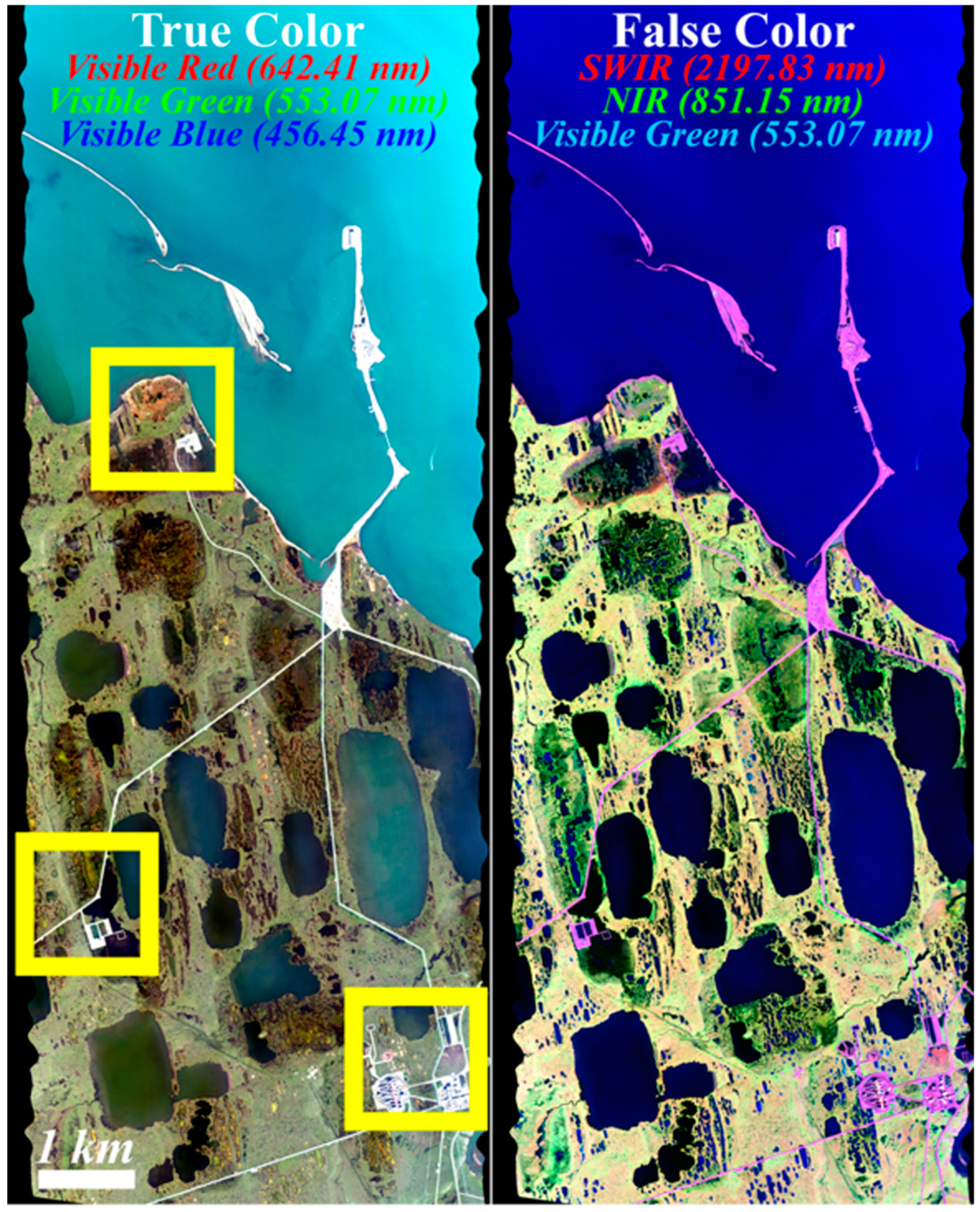
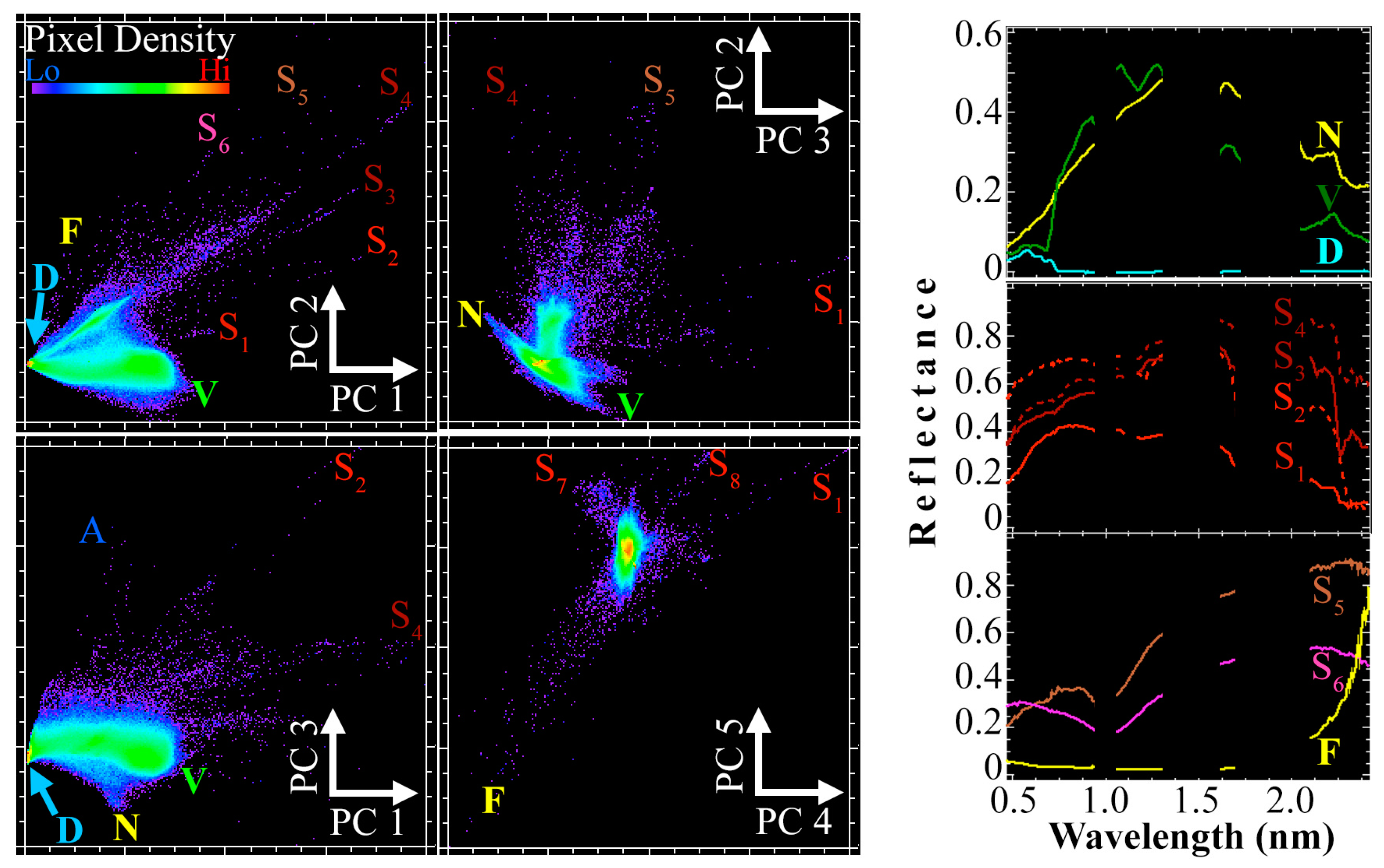
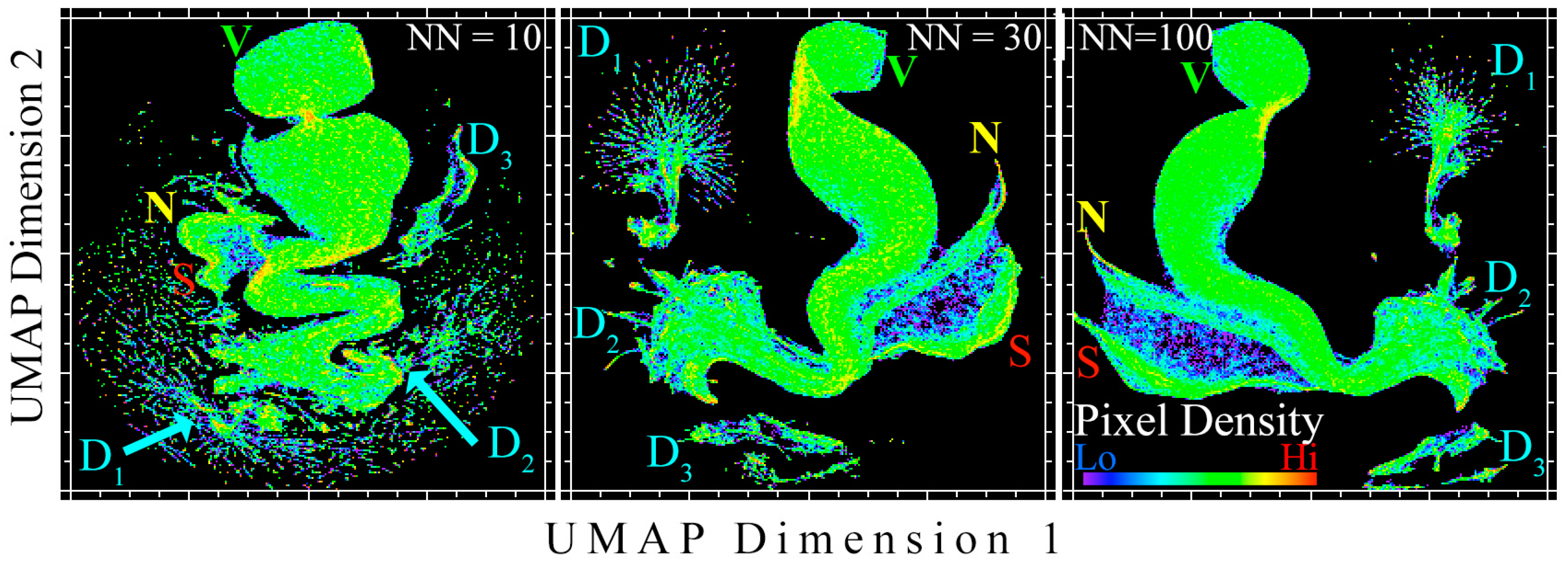

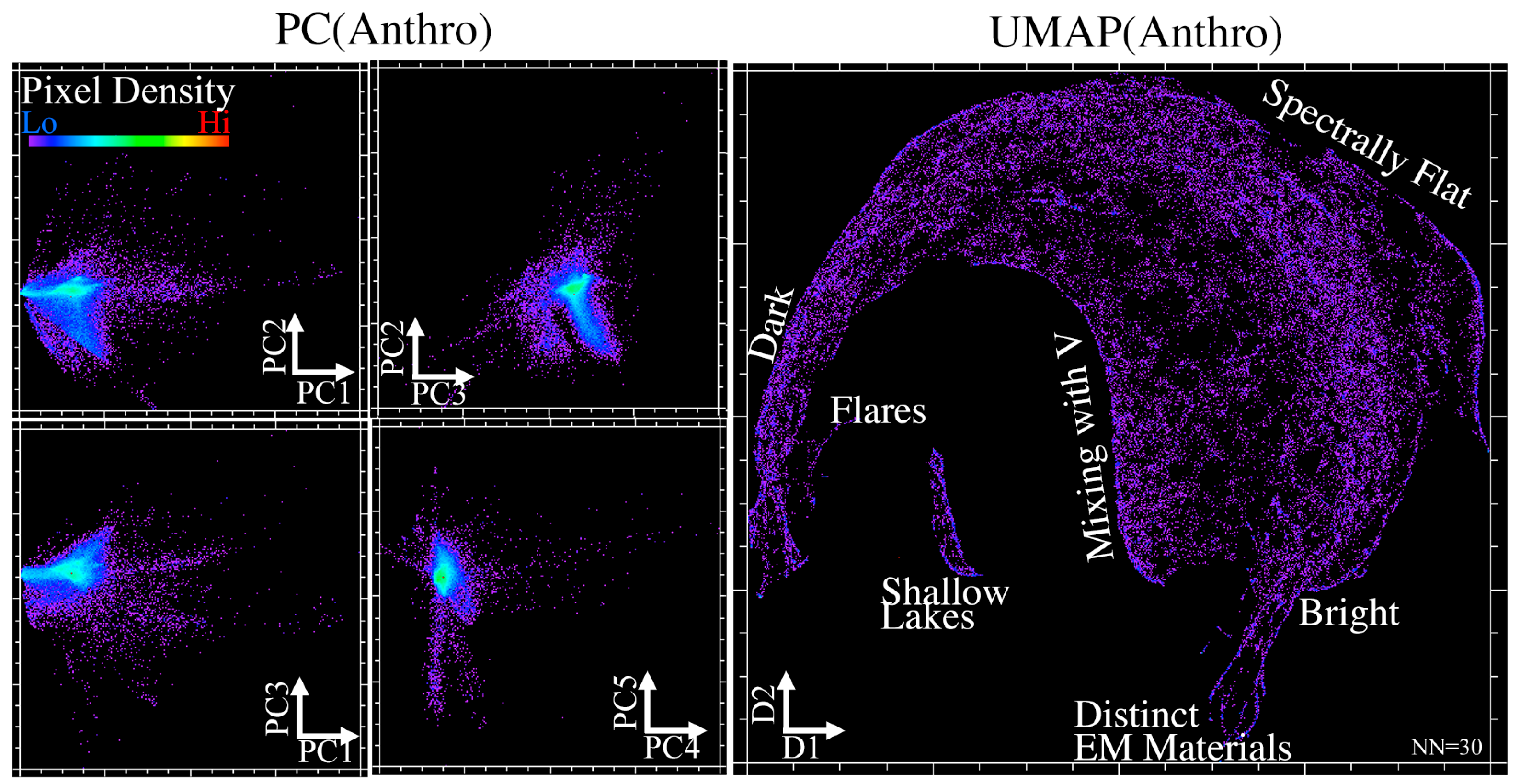
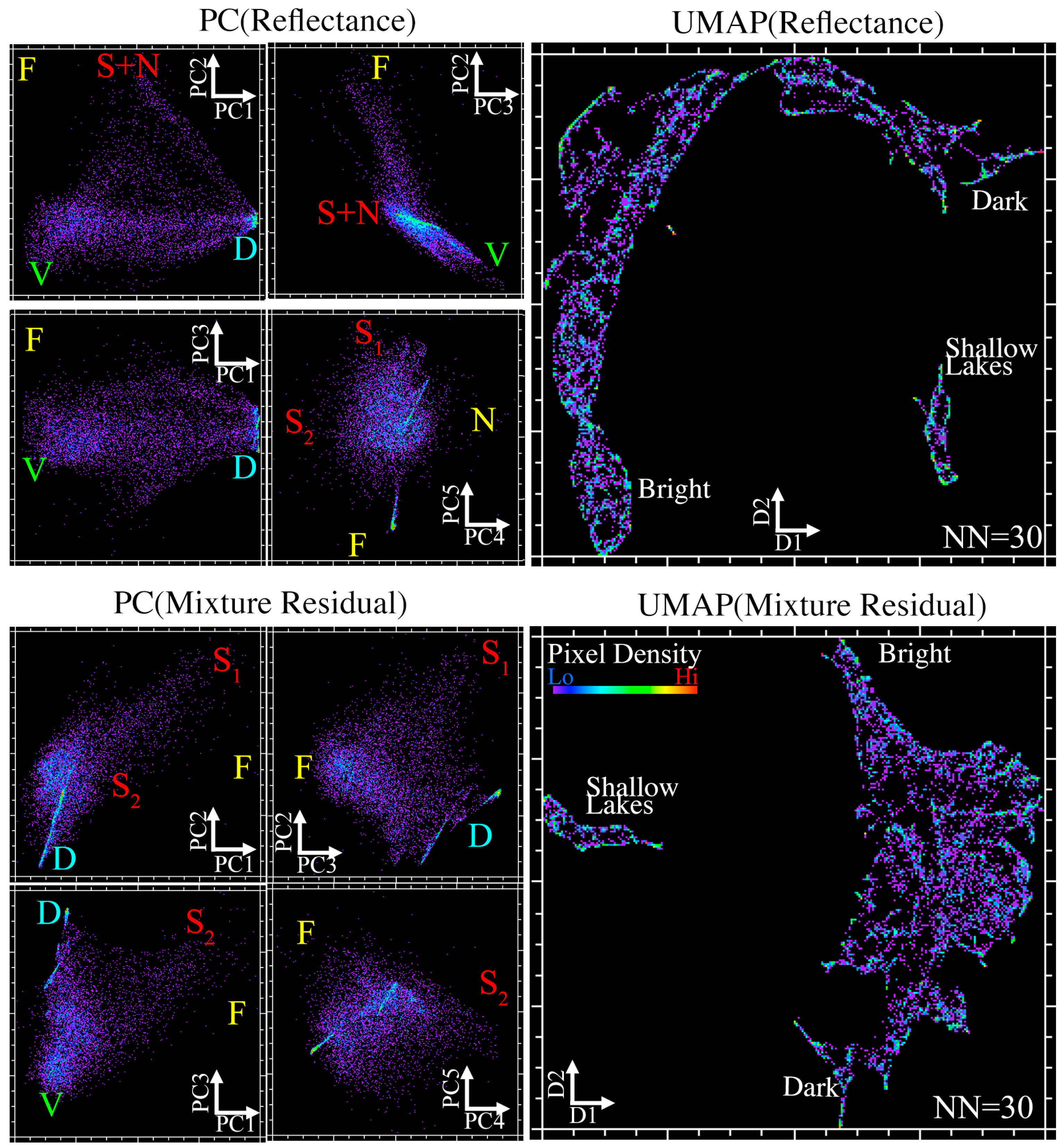
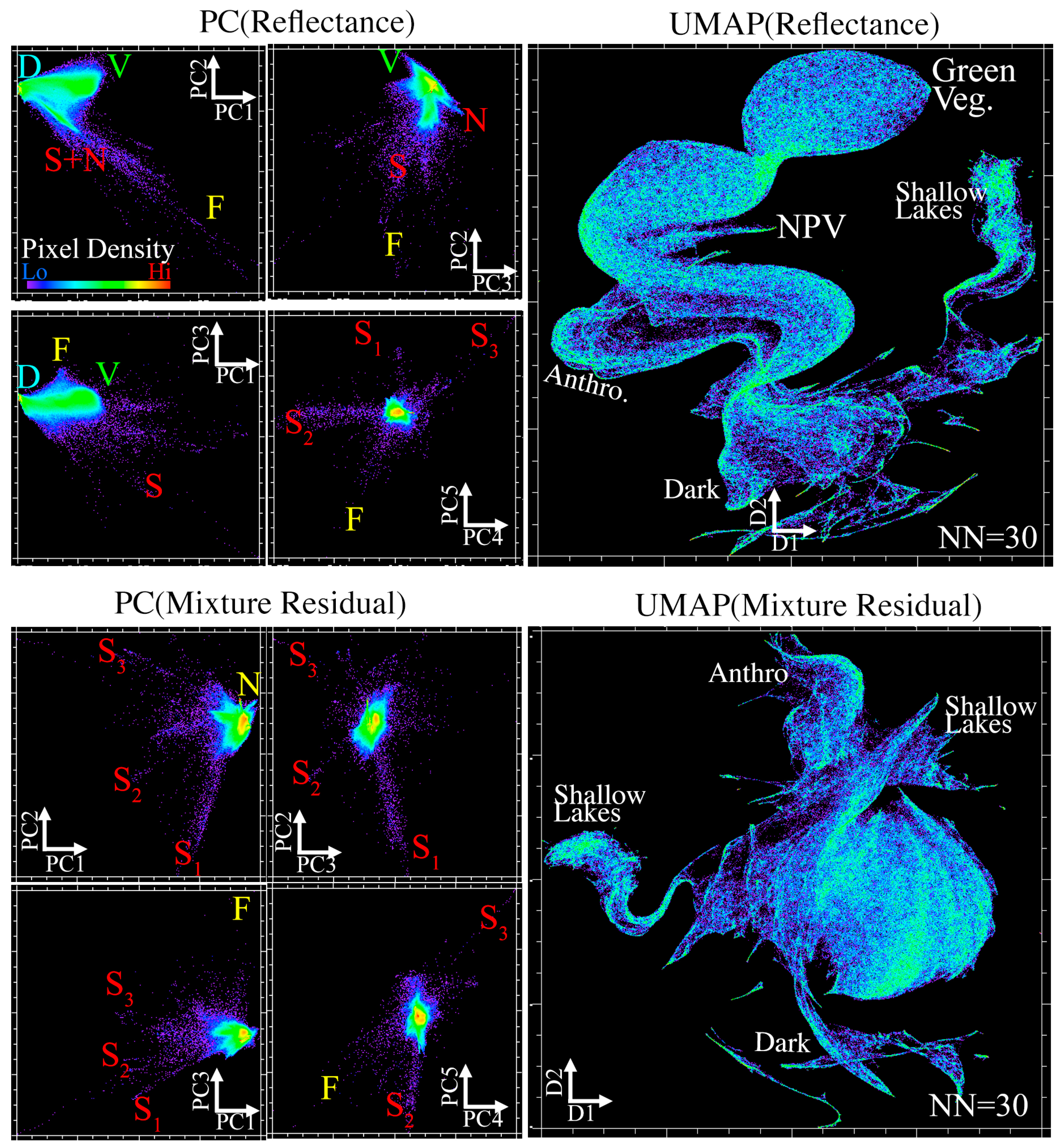

Disclaimer/Publisher’s Note: The statements, opinions and data contained in all publications are solely those of the individual author(s) and contributor(s) and not of MDPI and/or the editor(s). MDPI and/or the editor(s) disclaim responsibility for any injury to people or property resulting from any ideas, methods, instructions or products referred to in the content. |
© 2025 by the authors. Licensee MDPI, Basel, Switzerland. This article is an open access article distributed under the terms and conditions of the Creative Commons Attribution (CC BY) license (https://creativecommons.org/licenses/by/4.0/).
Share and Cite
Sousa, D.; Baskaran, L.; Miner, K.; Bushnell, E.J. Characterizing Sparse Spectral Diversity Within a Homogenous Background: Hydrocarbon Production Infrastructure in Arctic Tundra near Prudhoe Bay, Alaska. Remote Sens. 2025, 17, 244. https://doi.org/10.3390/rs17020244
Sousa D, Baskaran L, Miner K, Bushnell EJ. Characterizing Sparse Spectral Diversity Within a Homogenous Background: Hydrocarbon Production Infrastructure in Arctic Tundra near Prudhoe Bay, Alaska. Remote Sensing. 2025; 17(2):244. https://doi.org/10.3390/rs17020244
Chicago/Turabian StyleSousa, Daniel, Latha Baskaran, Kimberley Miner, and Elizabeth Josephine Bushnell. 2025. "Characterizing Sparse Spectral Diversity Within a Homogenous Background: Hydrocarbon Production Infrastructure in Arctic Tundra near Prudhoe Bay, Alaska" Remote Sensing 17, no. 2: 244. https://doi.org/10.3390/rs17020244
APA StyleSousa, D., Baskaran, L., Miner, K., & Bushnell, E. J. (2025). Characterizing Sparse Spectral Diversity Within a Homogenous Background: Hydrocarbon Production Infrastructure in Arctic Tundra near Prudhoe Bay, Alaska. Remote Sensing, 17(2), 244. https://doi.org/10.3390/rs17020244









